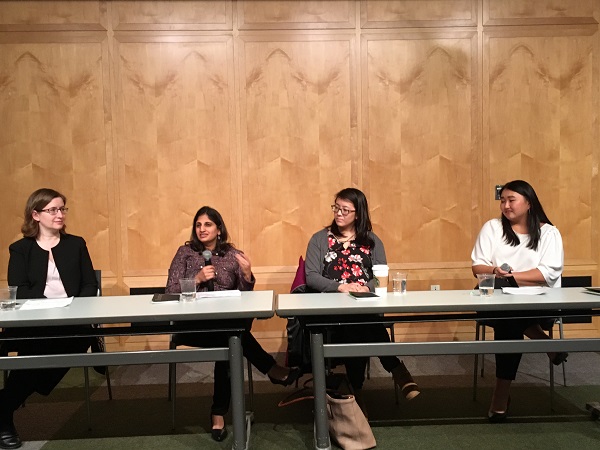At Princeton Public Library, Speakers Give Women Strategies for Advancing in Tech
Women working in or planning to enter the male-dominated technology industry need to develop strategies for overcoming the challenges they may encounter while pursuing their careers, said speakers from the business world and academia during a panel discussion on October 16 in Princeton.
The discussion, sponsored by the Princeton Public Library and Bloomberg, focused on women who are contemplating a career in technology or have already entered a tech field.
The panel’s speakers included moderator Carissa Zukowski, team lead of third-party fixed-income indices at Bloomberg and the co-lead of the Bloomberg Women in Tech community; Amanda Stent, a natural language processing architect and researcher at Bloomberg; Anjali Shah, a managing director at New York-based investment management firm BlackRock; and Jenny Shen, a doctoral candidate in economics at Princeton University who attended MIT as an undergraduate student.
All of the panelists shared their personal experiences of how they successfully managed to advance their careers in an industry that has a track record of attracting or hiring more men than women.
“There are just not as many women in this field. We’ve got to do a better job of getting kids interested earlier in technology,” said Shah.
The speakers told the mostly female audience that women working in technology industries should adopt various strategies if they plan on having successful careers. Here is what they had to say.
- Shah advised that women to take on more responsibilities at work, join networking groups, or engage in other activities “where you can add value” to an organization.
- Stent agreed that women seeking to elevate their careers must find opportunities that allow them to stretch themselves beyond their routine work duties, a requirement for senior-level roles at most companies. “Challenge yourself, and it will help you grow.”
- Zukowski said that the women who have successful careers are those who aren’t fearful of showing their personalities to others in their companies. She recalled her initial anxiety over managing other employees because of uncertainty over whether they would accept her as a leader. But her nervousness soon faded as she gained confidence in her ability to handle the job, which Zukowski said was accomplished by “learning to just be myself.”
- Stent said that technology companies could reap the benefits of adding more women to their ranks, but there has to be more career opportunities for them, such as more nominations of female employees for awards or promotions. “If we want successful and diverse organizations, we have to champion minorities.”
While some companies are hiring more women for technology jobs, the gender gap in tech careers hasn’t shown any signs of narrowing. According to a National Center for Women and Information Technology study, 26 percent of professional computing jobs were held by women in 2017. Yet women held 57 percent of jobs in all professional occupations during this period.
It’s even worse for women seeking senior tech executive positions. The study found that, as of 2017, only 17 percent of Fortune 500 CIOs were women.
One industry survey found that girls become interested in technology careers at about age 11, but their interest soon wanes. A lack of female mentors and gender inequality were cited among the reasons for the decline in interest.
The fact that fewer women hold tech jobs than other kinds of high-paying jobs could also be attributed to child-care responsibilities. Shen said that a research project she had worked on found that women who spent more time than their spouses caring for their children were not climbing the career ladder as quickly as their male counterparts.
The wide gap between men and women in the technology field may be partly the fault of the women’s parents, who often encouraged them to choose other professional career paths. Some parents “don’t talk about technology as a career like being a doctor or a lawyer,” Shah noted.


